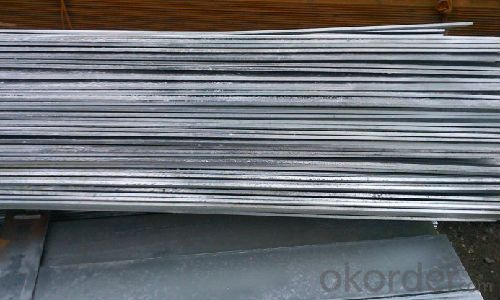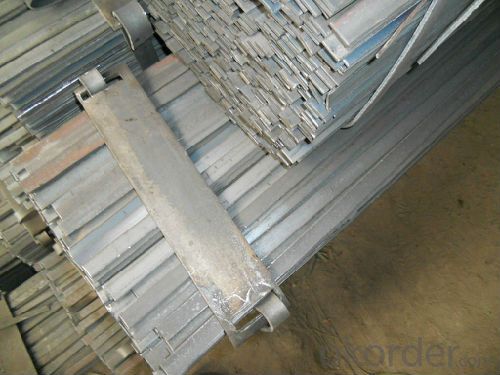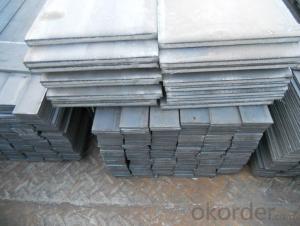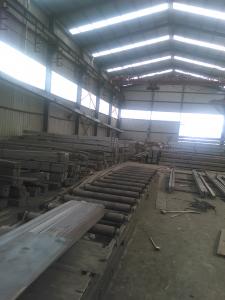Standard Size Q235 Hot Rolled Steel Flats from China
- Loading Port:
- China main port
- Payment Terms:
- TT or LC
- Min Order Qty:
- 50 m.t.
- Supply Capability:
- 200000 m.t./month
OKorder Service Pledge
OKorder Financial Service
You Might Also Like
Details of Standard Size Q235 Hot Rolled Steel Flats from China
| Minimum Order Quantity: | 25MT | Unit: | m.t. | Loading Port: | China Main Port |
| Supply Ability: | 80000-100000MTS/YEAR | Payment Terms: | TT or LC |
Specification of Standard Size Q235 Hot Rolled Steel Flats from China
Commodity: Q235 Steel Flat Bar
Standard: GB
Material: Q235
Brand name: FLATSPACE
Origin place: China
Thickness: 3mm-30mm
Width:20mm-200mm
Length: Max 12m
Certification: SGS/BV
Chemical composition of Standard Size Q235 Hot Rolled Steel Flats from China
Alloy No | Grade | Element(%) | ||||
C
| Mn
| S
| P
| Si
| ||
Q235
|
B
|
0.12—0.20 |
0.3—0.7 |
≤0.045 |
≤0.045
|
≤0.3
|
Physical properties of Standard Size Q235 Hot Rolled Steel Flats from China
Alloy No | Grade | Yielding strength point(Mpa) | Tensile strength (Mpa) | Elongation after fracture(%) | ||||||
Thickness (mm) | Thickness (mm) | |||||||||
≤16 | >16--40 | >40--60 | >60--100 |
| ≤16 | >16--40 | >40--60 | >60--100 | ||
≥ | ≥ | |||||||||
Q235 |
B |
235 |
225 |
215 |
205 |
375--500 |
26 |
25 |
24 |
23 |
Usage/Applications of Standard Size Q235 Hot Rolled Steel Flats from China
Widely used for construction, Machinery manufacturing, Iron tower steel structure, Shipbuilding; Steel grating, Staircase, Bridge, Viaduct, Railway spare parts, Boilers making etc.
Production Flow of Standard Size Q235 Hot Rolled Steel Flats from China
The steel flat bar is made through three processes:
1.Feeding the material: Feeding the row material (the steel plate) to Slitting Line.
2.Slitting:The steel plate would be slitted into expected width by lengthways cutter.
3. Leveled and cutting: The plat bar would be ground into level by the grinder and then cut into required length.
Packaging & Delivery of Standard Size Q235 Hot Rolled Steel Flats from China
Packaging Details: The Steel Flat Bars are packed in bundles and loaded in 20 feet/40 feet container, or shipped by bulk cargo ,also we can do as customer's requirements.
Delivery Details:30~45 days upon the receipt of buyer payment by T.T. or L/C.
Pictures of Standard Size Q235 Hot Rolled Steel Flats from China



- Q:What are the common forming techniques used for steel flat bars?
- Some of the common forming techniques used for steel flat bars include hot rolling, cold rolling, and extrusion. Hot rolling is a process where the steel is heated above its recrystallization temperature and passed through a series of rollers to reduce its thickness and shape it into a flat bar. This technique is commonly used to produce steel flat bars with precise dimensions and a smooth surface finish. Cold rolling, on the other hand, involves passing the steel through rollers at room temperature. This process is typically used to further refine the thickness and surface finish of the steel flat bar produced through hot rolling. Cold rolling can also increase the strength and hardness of the steel. Extrusion is another forming technique that involves forcing the steel through a die to shape it into a flat bar. This process is commonly used for producing steel flat bars with complex cross-sectional profiles or when there is a need for a high degree of precision in the final product. Other forming techniques for steel flat bars may include bending, shearing, and welding. Bending is often used to achieve specific shapes or angles in the flat bar, while shearing is used to cut the flat bar to the desired length. Welding is a joining process that can be used to connect multiple steel flat bars together or to other steel components.
- Q:Can steel flat bars be used for making hand tools or equipment?
- Yes, steel flat bars can be used for making hand tools or equipment. Steel is a durable and strong material that is commonly used in the manufacturing of various tools and equipment. The flat bars can be shaped and forged into different forms to create hand tools such as wrenches, hammers, chisels, and many more. Steel's high tensile strength and resistance to wear make it suitable for heavy-duty applications, making it a popular choice for manufacturing hand tools and equipment.
- Q:Can steel flat bars be hardened?
- Yes, steel flat bars can be hardened through a heat treatment process called quenching and tempering. This involves heating the steel to a high temperature and then rapidly cooling it in water or oil, which increases its hardness. The hardened steel can then be further tempered to improve its toughness and reduce brittleness.
- Q:How do steel flat bars perform in terms of chemical resistance?
- Steel flat bars generally have good chemical resistance, especially when compared to other materials like wood or plastic. However, the exact level of resistance can vary depending on the specific type of steel and the chemical it is exposed to. In general, steel is resistant to many common chemicals such as water, mild acids, and alkalis. However, it may corrode or react with certain aggressive chemicals or environments, such as strong acids, bases, or saltwater. Therefore, it is important to consider the specific chemical environment and consult relevant material compatibility charts or experts to ensure the appropriate level of chemical resistance for a particular application.
- Q:Connect the equipotential terminal box to the ground flat iron. Can I use plain flat steel?
- Specification requirement is 25*4 or 40*4 hot galvanized flat steel, said the family specification is also very reasonable, even galvanized flat steel, long time buried in the soil or on the floor, the wall will be laying, easy to rust, if we use the normal flat iron, not to mention that, certainly rust, but the speed is much faster than galvanized flat steel!
- Q:What are the weight and load-bearing capacities of different steel flat bar sizes?
- The weight and load-bearing capacities of steel flat bars can vary depending on their size. Generally, the larger the size of the flat bar, the higher its weight and load-bearing capacity. Here are some common steel flat bar sizes and their approximate weight and load-bearing capacities: 1. 1/8 inch thick steel flat bar: This is a relatively thin flat bar and is typically used for lighter applications. Its weight and load-bearing capacity can range from around 0.42 pounds per foot and 200 pounds per foot respectively. 2. 1/4 inch thick steel flat bar: This size is slightly thicker and can handle heavier loads. It typically weighs around 0.85 pounds per foot and has a load-bearing capacity of approximately 400 pounds per foot. 3. 3/8 inch thick steel flat bar: This size is even thicker and can support even greater loads. Its weight and load-bearing capacity can range from around 1.27 pounds per foot and 600 pounds per foot respectively. 4. 1/2 inch thick steel flat bar: This is a significantly thicker flat bar and is commonly used for heavy-duty applications. It weighs approximately 1.7 pounds per foot and has a load-bearing capacity of around 800 pounds per foot. 5. 1 inch thick steel flat bar: This is a very thick flat bar suitable for extremely heavy loads. It typically weighs around 3.4 pounds per foot and has a load-bearing capacity of approximately 1600 pounds per foot. It is important to note that these weight and load-bearing capacities are approximate values and can vary based on the specific grade and quality of the steel used. Additionally, other factors such as the length and support conditions of the flat bar should also be taken into consideration when determining its maximum load-bearing capacity. It is recommended to consult professional engineers or reference load tables provided by steel manufacturers for accurate and specific information on weight and load-bearing capacities of steel flat bars.
- Q:What are the safety considerations when working with steel flat bars?
- When working with steel flat bars, important safety considerations include wearing appropriate personal protective equipment (PPE) such as gloves, safety glasses, and steel-toed boots to protect against potential injuries from sharp edges or falling bars. It is crucial to ensure that the work area is well-ventilated and free from any flammable materials as sparks generated during cutting or welding processes can pose fire hazards. Additionally, proper handling techniques should be followed to avoid strains or injuries, and using appropriate tools and equipment, such as clamps or vices, can help stabilize the bars and minimize the risk of accidents.
- Q:How do steel flat bars contribute to the overall aesthetics of a project?
- Steel flat bars can contribute to the overall aesthetics of a project by adding a sleek and modern touch. Their clean lines and smooth surfaces create a visually appealing look that enhances the overall design. Additionally, steel flat bars can be versatile in terms of finishes and colors, allowing for customization and coordination with other elements in the project.
- Q:Are steel flat bars suitable for railway tracks?
- No, steel flat bars are not suitable for railway tracks. Railway tracks require a specific design and construction to ensure durability, stability, and safety. Steel flat bars lack the necessary strength and shape to support heavy loads and maintain track alignment. Specialized rail sections, such as the "T" or "I" shapes, are used to provide the required structural integrity and stability for railway tracks.
- Q:What are the different types of steel alloys used for flat bars?
- There are several types of steel alloys commonly used for flat bars, including carbon steel, stainless steel, alloy steel, and tool steel. Carbon steel is the most widely used and is known for its strength and durability. Stainless steel is highly corrosion-resistant and often used in environments with high moisture or chemical exposure. Alloy steel contains additional elements such as manganese, nickel, or chromium to enhance strength and toughness. Tool steel is specifically designed for use in cutting tools and has high hardness and wear resistance.
1. Manufacturer Overview |
|
|---|---|
| Location | |
| Year Established | |
| Annual Output Value | |
| Main Markets | |
| Company Certifications | |
2. Manufacturer Certificates |
|
|---|---|
| a) Certification Name | |
| Range | |
| Reference | |
| Validity Period | |
3. Manufacturer Capability |
|
|---|---|
| a)Trade Capacity | |
| Nearest Port | |
| Export Percentage | |
| No.of Employees in Trade Department | |
| Language Spoken: | |
| b)Factory Information | |
| Factory Size: | |
| No. of Production Lines | |
| Contract Manufacturing | |
| Product Price Range | |
Send your message to us
Standard Size Q235 Hot Rolled Steel Flats from China
- Loading Port:
- China main port
- Payment Terms:
- TT or LC
- Min Order Qty:
- 50 m.t.
- Supply Capability:
- 200000 m.t./month
OKorder Service Pledge
OKorder Financial Service
Similar products
New products
Hot products
Related keywords



























